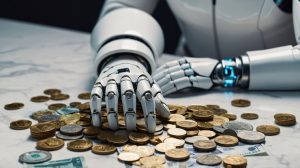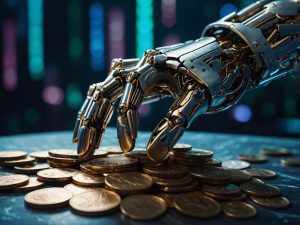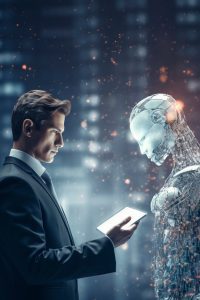Artificial Intelligence (AI) is rapidly emerging as a General-Purpose Technology (GPT), meaning it has broad applications across various sectors, significantly influencing the economy. From automation in manufacturing to data-driven decision-making in healthcare, AI’s transformative potential is reshaping industries and economies worldwide. In this article, we’ll explore the economic impact of AI as a GPT, its key benefits, real-world examples, and case studies that highlight its far-reaching implications.
Understanding AI as a General-Purpose Technology

A General-Purpose Technology is characterized by its wide application across different sectors, its ability to spur innovation, and its potential to drive long-term economic growth. Historical GPTs include electricity, the steam engine, and the internet—all of which revolutionized industries, boosted productivity, and fostered economic development. AI, as a GPT, holds similar promise, with applications ranging from healthcare and finance to retail and manufacturing.
Key Features of AI as a GPT:
- Automation: AI-powered systems automate repetitive tasks, increasing efficiency and reducing operational costs.
- Data Processing: AI algorithms can analyze vast amounts of data, uncovering insights that drive better decision-making.
- Innovation Catalyst: AI fosters innovation by enabling new products, services, and business models.
- Scalability: AI technologies can be scaled across industries, from small businesses to global corporations.
Economic Benefits of AI as a General-Purpose Technology
The economic impact of AI is evident through its capacity to enhance productivity, reduce costs, and create new opportunities. Here are some of the key benefits AI offers to the global economy:
Increased Productivity and Efficiency
AI automates mundane and repetitive tasks, allowing workers to focus on higher-value activities. For example, in manufacturing, AI-powered robots streamline production lines, improving efficiency and reducing downtime. In the financial sector, AI algorithms process transactions and detect fraud faster than human analysts. This leads to increased productivity across industries, driving economic growth.
Case Study: Siemens’ AI Automation in Manufacturing
Siemens has integrated AI into its manufacturing processes, leveraging machine learning algorithms to optimize production lines. AI-powered robots have reduced the time it takes to manufacture complex components, boosting productivity and cutting costs by 30%. This case highlights AI’s ability to revolutionize traditional manufacturing systems, driving economic efficiency.
Cost Reduction and Resource Optimization

AI technologies help companies reduce costs by optimizing resource allocation. For instance, AI-driven supply chain management systems predict demand patterns, enabling businesses to minimize waste and avoid overproduction. In healthcare, AI-powered diagnostic tools reduce the need for expensive and time-consuming tests, cutting costs for both providers and patients.
Example: Nvidia’s AI Solutions for Energy Efficiency
Nvidia, a leader in AI hardware and software, has developed AI solutions that optimize energy usage in data centers. By using AI to predict energy consumption patterns, companies can reduce their energy bills by up to 40%. This not only saves costs but also contributes to sustainability efforts.
Job Creation in High-Skill Sectors
While AI is often associated with job displacement, it also creates new opportunities in high-skill sectors such as data science, AI engineering, and software development. As companies adopt AI technologies, the demand for skilled professionals who can develop, manage, and maintain AI systems continues to grow.
Case Study: Tempus’ AI-Driven Healthcare Platform
Tempus, an AI-driven healthcare technology company, uses AI to analyze clinical and molecular data, providing personalized treatment options for cancer patients. The company’s success has led to the creation of thousands of jobs in data science, bioinformatics, and AI development. This case demonstrates how AI can create high-skill jobs, driving economic growth in the healthcare sector.
Innovation and New Business Models
AI enables businesses to develop new products and services that were previously unimaginable. For instance, AI-powered recommendation systems in e-commerce platforms such as Alibaba personalize shopping experiences, leading to increased customer satisfaction and higher sales. Additionally, AI-driven financial services, like Oracle’s AI-based fraud detection, have redefined how companies manage risk and ensure compliance.
Example: Hugging Face and AI-Powered Natural Language Processing
Hugging Face, a leading provider of AI tools for natural language processing (NLP), has developed models that help companies understand and respond to customer inquiries in real-time. These AI-powered NLP tools have transformed customer service in industries like retail, finance, and healthcare, creating new business models and improving customer engagement.
Enhancing Global Competitiveness

Countries that invest in AI technologies are likely to gain a competitive edge in the global economy. For instance, China has made significant investments in AI, aiming to become a global leader in AI development. AI adoption enhances productivity, drives innovation, and fosters international competitiveness.
Case Study: Tesla’s AI-Powered Autonomous Vehicles
Tesla’s advancements in AI-powered autonomous driving technology have positioned the company as a leader in the electric vehicle market. By leveraging AI for self-driving capabilities, Tesla has not only revolutionized the automotive industry but also created a new competitive dynamic in global transportation markets. This case highlights how AI can enhance a company’s, and even a nation’s, competitiveness on the global stage.
Challenges and Considerations
Despite the numerous benefits AI offers, there are challenges that must be addressed to fully realize its economic potential. These include:
Workforce Displacement
While AI creates high-skill jobs, it also displaces workers in sectors where automation replaces manual tasks. Companies must invest in retraining and reskilling programs to ensure that displaced workers can transition into new roles in the AI-driven economy.
Ethical and Privacy Concerns
The widespread use of AI raises ethical concerns, particularly regarding data privacy. As companies like Google and Oracle develop AI systems that process sensitive data, there is a growing need for regulations that ensure data protection and ethical AI deployment.
Access to AI Technologies

While large corporations like Siemens, Nvidia, and Tesla have the resources to invest in AI, smaller businesses may struggle to adopt these technologies. Ensuring equitable access to AI tools and resources is crucial for fostering widespread economic benefits.
The Future of AI as a General-Purpose Technology
As AI continues to evolve, its role as a GPT will expand, driving further economic growth and innovation. Some of the emerging trends include:
- AI in Healthcare: Companies like Tempus and others are developing AI-driven tools that personalize treatment plans, improving patient outcomes while reducing healthcare costs.
- AI in Energy: With the increasing focus on sustainability, AI solutions that optimize energy consumption, such as Nvidia’s AI-driven energy management tools, will play a critical role in reducing carbon footprints.
- AI in Finance: AI-driven financial services from companies like Oracle are redefining how businesses manage risk, detect fraud, and ensure compliance, leading to safer and more efficient financial systems.
Conclusion
AI, as a General-Purpose Technology, is reshaping the global economy by enhancing productivity, reducing costs, and fostering innovation across industries. From Siemens’ AI-driven manufacturing processes to Tesla’s autonomous vehicles, the impact of AI is profound and far-reaching. While challenges such as workforce displacement and ethical concerns must be addressed, the potential for AI to drive long-term economic growth is undeniable. As AI continues to evolve, its role in the global economy will only expand, making it a key driver of future prosperity.












